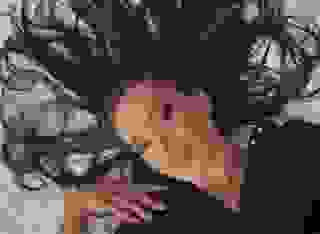- Sci-Fi & Fantasy
- The Feast of The Tail Ch. 08
Note: You can change font size, font face, and turn on dark mode by clicking the "A" icon tab in the Story Info Box.
You can temporarily switch back to a Classic Literotica® experience during our ongoing public Beta testing. Please consider leaving feedback on issues you experience or suggest improvements.
Click hereIsis was back in the land of black sand. She stood beside her long dead ancestor, Hatshepsut at the base of the slope leading to Hatshepsut's mortuary temple carved into the stone cliffs on the west bank of the Nile. They have never met, and yet Isis knows her, she has always known her.
She understands now that Hatshepsut has always been with her, beyond her sight. When the sun travels west under the earth it goes to the Duat. The Duat is beneath us, under us, beside us always. This is where Hatshepsut is, this is where Isis is now: the Neter World.
They walk side by side up the ramp to the temple, no winds blow and the stars above them are silent. Isis looks up and she can see, in the sky, the swell of the seas as though they are under the black water of the world's deepest ocean. Strange shadows swim above them in the place where light does not reach.
A river flows from the sea in the sky down to the black sand by their feet. There are thousands of boats on the river, and in each boat is a light, and each light is a soul. Isis looks at each of them, a maiden, a child, a man, a crone. But as she looks at each soul they shift, from child, to adult, to elder. All the things they were, or would have been, all at once.
"I have something to show you, child of my blood." Hatshepsut spoke, her voice abnormally deep, her lips unmoving. She spoke with her mind alone. "The history of my divinity. My conception on the day Amun disguised himself as my father. My destiny to become Pharaoh."
They are within the temple, it was as though they had disappeared in one place and appeared in another. Thought had brought them to the place they were thinking of. Knowingly Hatshepsut said, "Will and desire move you differently in the Neterworld."
"So this is the Neterworld?" Isis asked.
"Yes. The land that runs through us and under us, the land of the Gods. The land of dreams, where the living and the dead walk side by side, as shape and shadow. The timeless, infinite land, a place of what was, what is, what will be and all the things that could. I reside here, in the place where word and deed shape the destiny of the living."
All around Isis are the eyes of Horus, painted eyes that float through the empty space around her head, looking at her, looking within her, looking through her, trying to show her what to see.
They stand together, two women of an ancient bloodline, side by side before the walls of the temple. The paintings are familiar to Isis, she has been here many times before in her waking life.
Hatshepsut is on the walls as a painting, but the paintings are moving. The symbols and art are alive. Isis sees Hatshepsut as a baby, cradled in the arms of Isis, sucking at the breasts of the goddess. To be suckled by a goddess is to be given the milk of divinity, to become one of the gods, to become an immortal. The paintings on the walls prove Hatshepsut's divinity. She was suckled by Isis.
What is written must be true.
Heka, the god of magic, Hu, Sia and Werethekau stand beside the child. Heka places the ankh of life in Hatshepsut's mouth. Hatshepsut has been given life and magic by the Gods. Khnum the potter has shaped the body of the child on his wheel. Hatshepsut is depicted as a boy child, cementing her right to rule. Thutmose II is shown declaring that Hatshepsut is his rightful heir.
"This daughter of mine, Khnumetamun Hatshepsut--may she live!--I have appointed her as my successor upon my throne. She shall direct the people in every sphere of the land; it is she indeed who shall lead you. Obey her words, unite yourselves at her command. May she be eternal!"
What is written must be true.
As they walk down the corridor they can see the story carved into the walls change through time. The child Hatshepsut begins to shine, her black skin is alchemically turned to solid gold. Gold, the colour of divinity. The painted walls shine and come alive, Hatshepsut's name is encircled in a shenu. She is given the title Daughter of Amun, Ruler of Upper and Lower Egypt.
The oracle of Amun is depicted and proclaims it is the will of Amun for his daughter to reign. Amun's words of approval are carved into the walls.
"Welcome my sweet daughter, my favorite, the King of Upper and Lower Egypt, Maatkare, Hatshepsut. Thou art the Pharaoh, taking possession of the Two Lands."
What is written must be true.
Hatshepsut gives Isis the reed brush of a scribe.
"Write your history, write your future."
Suddenly Isis is no longer in the temple, she is in the palace at Thebes, but it is 150 years ago and Hatshepsut has not yet been born. She is standing in the bedchamber of her father Amenhotep. Isis recognises the room, but it is not her father's bedchamber, it belongs to Thutmose I, Hatshepsut's predecessor. Isis can tell from the cartouche that holds his name carved into all the walls. Time has turned backwards.
The Gods stand around the bed. Amun, Atum, Shu, Tefnut, Osiris, Isis, Set, Nephthys, Thoth, Anubis, Neith. They are radiant, mystical, eternal.
Ahmose, the Great Wife of the Pharaoh is alone, waiting for her husband, but she cannot see them, she cannot hear them, she does not feel their touch. Ahmose is only mortal. No one but Isis can see the Gods.
"The Queen is to receive the soul of the divine child in her womb." spoke the ibis headed Thoth to golden clothed Amun, glancing briefly at Isis.
Hatshepsut does not yet exist, and yet she is here, she is showing Isis what she must see.
Amun, with red skin and plumed crown carries a staff, the sceptre of Kings. He taps the ground once with the staff, causing a flash of light, pure sunlight is in his hand in the form of an ankh. The ceiling fills with clouds and the sound of eternity bellows around them, a deep, angry, primeval sound.
Amun takes the light and places it into his mouth and swallows it. He transforms, he begins to take the form of the Pharaoh, he changes himself into Thutmose I as easily as you or I could change our clothes.
Amun becomes Thutmose, he is the Pharaoh and the God all at once. He begins to kiss and cover Queen Ahmose who lies beneath him.
"Inhale the breath of life." He whispers tenderly, as Ahmose gasps and moans under the God who is also her husband, inhaling the orb of light into her body, which passes from his breath into hers. She does not know, she does not see. Her belly begins to radiate pure white light, Amun pours his seed into her, and as he does the water of the Nile floods the room and rises to the ceiling, but they do not drown, they do not choke. The Gods stand like stones in a circle, even as fish begin to swim around their heads. The lovers in bed below them take shelter in each others arms. Ahmose is unaware of the waters of life that inundate her bedroom.
"You see, my father is Amun, he gave me divinity." Hatshepsut speaks with closed lips to the dreamer. "You, my descendant, are also divine. Isis chose you long before you were born, long before you were named. You were born as thought from the goddess herself."
Suddenly the room is half filled with sunlight and half filled with the starry sky. Divided into day and night. Time has passed, Ahmose is sat atop a couch, held up by the goddesses Neith and Serkhet. The Queen's belly is full from pregnancy, and Amun sits beside her as Isis and all the gods around her continue to watch with eyes that do not blink and mouths that do not open.
"You will give birth to a powerful Queen, Ahmose. She is the daughter of Amun, so she is divine. She will become Pharaoh and she will rule the lands of Upper and Lower Egypt."
Echoed in his voice, as though he speaks two sentences at once, Amun says to the dreamer.
"You will be Queen of Upper and Lower Egypt, Lady of Two Lands, Isis, daughter of Tiye, daughter of blood and moon, magic and dune."
The eyes of Horus are looking at her, the eyes of the Gods are looking at her, the Goddesess, the stars and the walls have eyes and they all look at her. She is looking at herself, from above and below. She is looking at herself through a mirror, through time. Her life seen through the eyes of all that have ever looked upon her.
Amun continues to speak, voice echoing in her head and around the room, lips unmoving. "You are the one who devours, who devours yourself, who creates yourself, the one who eats the souls of On. Daughter of the Stranger, Priestess of the Jackal, Daughter of Pharaoh, High Priestess of Isis, Daughter of Magic. The blood drinker, soul devourer, eating the flesh of your family, child of Queens, mother of Kings. You will unite the two lands of Life and Death. The Upper and the Lower, as above so below."
Isis begins to realise she is screaming.
Below her lies Djhutmose in thirteen pieces, Osiris with the crook and flail across his chest, lying in a sarcophagus in a boat that travels across the Nile, across the river of death, and the river and the water is blood.
Isis cries and cries and cries and the river floods across the land, water of black blood that flows into the sea and across the earth, but in the distance a light, bright light and strange sounds. Sounds that won't make sense for thousands of years.
The images happen all at once, like looking at shards of a shattered mirror, of glass stained with blood, all the scenes from different times splintering in Isis' mind. In one shard Isis sees Khnum the potter shaping the body of the child Hatshepsut on his wheel. In another shard Ahmose is led by the goddess Heqet to a lioness shaped bed where she lies down to give birth to Hatshepsut. Ahmose screams as her birth canal is opened. There are millions of shards. She sees Sitamun with the Pharaoh. Sitamun on the throne. Sitamun lying with her throat slit on the streets of Thebes. A boy Pharaoh. White skinned men breaking into his tomb. A library burning. Dhjutmose smiling at her for the last time. A man with black skin and red hair. The sun shining over the pyramids at Giza. The pyramids being buried under the sands. Locked in a stone tomb, being buried alive.
Isis tries to piece the shards together, she tries to put it back in order, but it doesn't fit. There is a piece missing.
Khnum the potter is at his wheel, and the wheel is the earth spinning on its axis.
"Construct the body and the ka out of clay, and then breathe life into it. Breathe life into it. Breathe life into it, Isis, daughter of Egypt."
Isis can hear the cry of a baby, she can feel her mortal body begin to wake and tries to hold on to the dream. So close, she knows she's so close, just a little more. The last thing she sees is a baby suckling at her breast, it is Horus, and then it is a dark skinned boy. He looks like her, he looks like Djhutmose.
She sees a city that she's never seen. Filled with towers of light and mirrors. Thousands of towers of metal that shine like silver, stronger than bronze, metal unlike anything forged in Egypt. And yet it is from this strange city that she rules the world.
"They tried to erase me. They struck my name from the walls so Egypt would forget that a woman was Pharaoh. This will be your destiny. Do not let yourself be forgotten." Hatshepsut whispers in Isis' ear, caressing her cheek before biting down on her throat, hard.
Notes for this chapter on the ancient Egyptian language
Hatshepsut - the female Pharaoh of the 18th dynasty
Neter - the Ancient Egyptian word for God
Amun - 'The Hidden One'. Patron deity of Thebes. God of Wind, eventually combined with the sun god Ra to become Amun-Ra to represent the transcendental, self created deity. As Amun-Ra he was the creator god, fertility god and solar god. One of the most important in the Egyptian pantheon.
Atum - God of pre-existence and post-existence. The Complete One, the Finisher of the World. Considered by some to be the First God, the one who created himself out of nothing
Shu - šw, "Emptiness" or "He Who Rises Up". God of the Air and supporter of the Sky. Associated with lions, air, wind and peace. Brother and husband of Tefnut. Represented coolness, calmness and peacefulness.
Tefnut - Goddess of Rain, Dew and Moisture. Wife of Shu. Mother of Nut, the sky goddess and Geb, the earth god. Grandmother of Osiris, Isis, Set and Nephthys. One of the Gread Ennead, the nine gods and goddesses of Heliopolis which included, arguably, the most popular and well known gods.
Osiris - wsjr. 'Lord of the Dead'. 'Lord of Silence'. 'He Who is Permanently Benign and Youthful'. God of fertility, agriculture, afterlife and rebirth. Associated with the cycles of nature and the annual flooding of the Nile and growth of fresh, young, green vegetation. He is depicted symbolically with green skin. Also associated with mummification because of the myth of Isis wrapping him up to put him back together. Husband and brother of Isis and father of Horus. Sometimes referred to as 'Khenti-Amentiu' meaning 'Foremost of the Westerners', a title also used by Anubis. Usually depicted with the atef, a feathered white crown. Also depicted holding a crook and flail, symbols of the authority of Pharaoh.
Isis - Probably pronounced 'Aset' or 'Iset'. Her name literally means throne in ancient Egyptian. She personified the throne and had the ability to make men kings. Mother Goddess. Goddess of Magic. She was said to have the greatest magical power of all the gods. She protected Egypt from its enemies, she governed the natural world and had power over fate itself. Goddess of Healing. She could bring the dead back to life and cure the sick, she was the one who revived Osiris after he was murdered by his brother Set in the Osiris myth. Sister and wife of Osiris and mother of Horus. Taught mortals how to weave, bake and brew beer.
Set - God of deserts, storms, disorder, violence, and foreigners. 'Lord of the Red Land' - the Red Land symbolised the inhospitable Desert. Murderer of his brother Osiris and rival of his nephew Horus. Said to have forceful, potent, and indiscriminate sexuality and had several homosexual encounters with his nephew.
Nephthys - Sister of Isis. Sister and wife of Set. Associated with mourning, the night, darkness, service (specifically temples), childbirth, the dead, protection, magic, health, embalming, and beer. A goddess who symbolises the experience of death, as her sister Isis symbolises the experience of birth. She was also associated with the kite or Egpytian hawk, perhaps because of their sorrowful and mournful cries, associated with crying for the loss of a loved one. Nephthys is not evil, although she is fierce and powerful. She aids her sister Isis in finding the cut up parts of Osiris and she acts as a nurse, caretaker and guardian to the infant Horus.
Thoth - Ḏḥwtj/ḏḥwtj "He is like the Ibis". God of Wisdom, God of the Moon, God of Science, the arts of magic, the system of writing, hieroglyphs, art and the judgment of the dead. Later associated with the god Hermes.
Anubis - Also known as Anpu or Inpu. "He Who Is upon His Mountain","Lord of the Sacred Land," "Foremost of the Westerners,", "Conductor of Souls" and "The Dog who Swallows Millions". God of the Dead and the Underworld. Depicted with the head of a jackal. He attended the weighing scale during the "Weighing of the Heart", in which it was determined whether a soul would be allowed to enter the realm of the dead.
Neith - 'She is the Terrifying One', 'The Mother of Mothers'. She was said to be the first and the prime creator, who created the universe and all it contains, and that she governs how it functions. She was the goddess of the cosmos, creation, fate, wisdom, water, rivers, mothers, childbirth, hunting, weaving, and war.
Heka - the god of magic whose name was identical to the ancient Egyptian word for magic. According to ancient Egyptian writing, Heka existed long before duality had come into being. In the Old Kingdom Heka represented the supernatural energy of the Gods. The 'Cannibal Pharaoh' needed to devour the Gods in order to absorb their power.
Hu - ḥw in the old kingdom of ancient Egypt, was the deification of the first word, the word of creation, that Atum was said to have exclaimed upon ejaculating or, alternatively, his circumcision, in his masturbatory act of creating the Ennead. In the middle kingdom Hu was considered the deification of the first word of creation uttered by Ptah.
Sia - Also known as Saa. The deification of perception, especially the accurate perception which is necessary in order to understand truth. The Sia hieroglyph was also used to represent the meaning "to perceive", "to know" or "to be cognizant". Often connected with writing and when personified was depicted as a man holding a papyrus scroll. Sia was often depicted standing alongside Hu. Hu was the first word and Sia was perception. It was implied that they came into existence together.
Werethekau - wrt-hkw "Great One of Magic, Great Enchantress" also known as Urthekau or Weret Hekau. She is the goddess of supernatural powers. Often depicted as snake or lion headed. Her name was often inscribed as a protective charm on weapons such as knives and daggers. According to Wikipedia her power was one of the inherent qualities of the Crowns of Egypt.
Shenu - the ancient Egyptian name for a cartouche
Thutmose I - Father of Hatshepsut. His name means 'Thoth is Born'. Third Pharaoh of the 18th dynasty of Egypt.
Ahmose - Mother of Hatshepsut. Her name means 'The Moon is Born' or 'Child of the Moon'. She was the primary wife and Great Royal Wife of Thutmose I. To legitimise her daughter's reign as Pharaoh she was depicted as being visited by Amun to conceive Hatshepsut. These images were carved on the walls of Hatshepsut's temple. Later in the 18th dynasty, Amenhotep III would copy these images and replicate them to show his mother Mutemwiya also conceiving him by the god Amun.
Heqet/Heket - ḥqt, also ḥqtyt pronounced Heqatit. Goddess of frogs, floods and fertility. Her name may be connected to the origin of the ancient Greek goddess Hecate, goddess of witchcraft.
Khnum - Also spelled Khnemu, ancient Egyptian god of fertility, associated with water and with procreation. Originally the god of the source of the Nile. According to Wikipedia since the annual flooding of the Nile brought with it silt and clay, and its water brought life to its surroundings, he was thought to be the creator of the bodies of human children, which he made at a potter's wheel, from clay, and placed in their mothers' wombs. He was later described as having moulded the other deities, and he had the titles "Divine Potter" and "Lord of Created Things from Himself".
- COMMENTS








